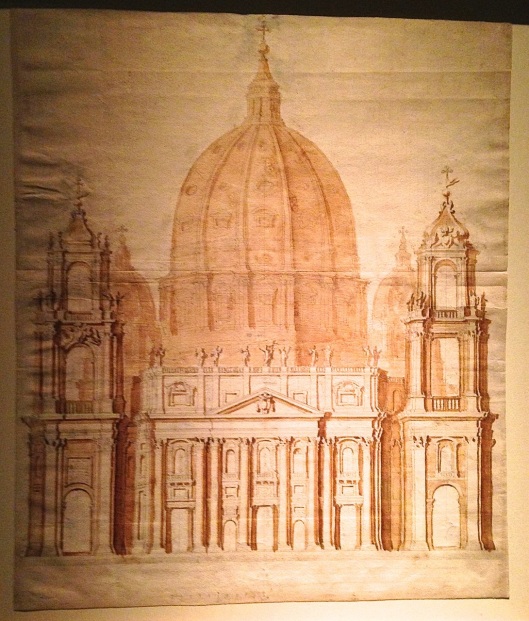Tags
architecture, art history, Baroque, Bernini, Borromini, Francesco Borromini, Gian Lorenzo Bernini, Gianlorenzo Bernini
“You must be in heaven!” my friend Toni messaged me. And she was right. She’d written in response to this photo (below) I’d posted of Gian Lorenzo Bernini‘s lion, a model for part of his Four Rivers fountain that’s just one of the exhibits in Il Laboratorio del Genio: Bernini Disegnatore, which is currently showing at the Palazzo Barberini in Rome, until May 24.
I fell in love with Bernini and his genius years ago at the Galleria Borghese where his incredible sculptures of Apollo and Daphne, the Rape of Proserpine and his masterful (and super studly) David are all on magnificent display. Having read a lot about my 400-year-old boyfriend, I knew he’d also earned a reputation as a painter but until I visited this Barberini exhibit I hadn’t had many opportunities to see his drawings—to witness the Cavaliere’s genius in progress.
The exhibit, which brings together sketches from museums all over the world, is divided into several sections, including portraits; ancient designs; St. Peter’s and the Vatican; and fountains, obelisks and statues.
It begins with several self-portraits by Bernini. He greets you in all his intensity right at the door.
And all the portraits, whether of himself or others, have a similar intensity in the eyes. No doubt his own keen observation of the world around him, and his ability to translate the inherent emotion onto the page or into marble, helped bring out his genius.
A child prodigy, Bernini flourished as a favorite of Maffeo Barberini (who became Pope Urban VIII) and Scippione Borghese, the church’s No. 2 man and an obsessive art collector. The show displays several sketches of the men who hired and influenced Bernini’s career, but only Barberini is depicted in full-color glory.
Bernini so impressed Maffeo, that while still a teenager, the young artist was invited to spend his days in the Vatican’s private art collection, honing his craft by sketching copies of some of the classic sculptures on display. Sometimes Bernini wouldn’t come home for days on end, and when asked where he’d been, according to Franco Mormando, author of Bernini: His Life and His Rome, he would joke that he’d been with his “girlfriends,” as he called the sculptures at the Vatican.
Many of the works show how Bernini studied and took his ideas from the page to reality—a few sculptures and models are placed strategically in the rooms. For instance, the head of the famous statue of Laocoön — a Trojan priest who was strangled by snakes sent by the angry gods after he tried to warn that the Greeks’ Trojan horse was a trap — sits near Bernini’s sketches of the body. The ancient Greek statue, considered by some to be among the best sculptures ever made, is one that Bernini studied intensely in his early years. And it seems obvious that sculpture was his true passion. Just look at the expression on the face of Laocoön, the furrowed brow: you can feel his regret and pain.
The exhibit—dimly lit to protect the artwork, so prepare to squint—also includes drawings of designs for some of Bernini’s architectural projects, such as Sant’Andrea al Quirinale, a church near Rome’s Piazza Quirinale that’s an exquisite example of the Baroque at its most hyperactively decorative.
The show also tackles the “rivalry” between Bernini and the architect Francesco Borromini (which I wrote about previously, see #4 here), showing some of the detailed sketches both men made for the baldacchino over the main altar in St. Peter’s Basilica. As a young man, Borromini worked as a kind of sub-contractor on parts of Bernini’s complex commission at St. Peter’s.

Bernini’s sketch, probably quickly drawn for Pope Urban or another VIP, to show how the Baldicchino would be finished
It’s fascinating to see how the men were at times almost collaborators. Some sketches even show their differing takes on the bell tower for St. Peter’s—one of Bernini’s great failures, as his tower reportedly caused cracks to appear in the Basilica’s facade, threatening collapse. At that point Borromini and several other architects jumped in to try to fix the debacle.
 The exhibit wraps up with some designs for Bernini’s well-known fountains and outdoor statues, including the lion and a few sketches for the Elephant Obelisk, which stands outside the church Santa Maria sopra Minerva, near the Pantheon. There’s a story about the elephant that says Bernini intentionally placed the sculpture so that its rear end would face the building that, at the time, was a palazzo used by the Inquisition (could Bernini’s dislike for the Inquisition be why the elephant looks so angry in the drawing?). But the story is probably apocryphal.
The exhibit wraps up with some designs for Bernini’s well-known fountains and outdoor statues, including the lion and a few sketches for the Elephant Obelisk, which stands outside the church Santa Maria sopra Minerva, near the Pantheon. There’s a story about the elephant that says Bernini intentionally placed the sculpture so that its rear end would face the building that, at the time, was a palazzo used by the Inquisition (could Bernini’s dislike for the Inquisition be why the elephant looks so angry in the drawing?). But the story is probably apocryphal.
If you’re in Rome and have a chance to see this wonderful show (likely without crowds, I had my boyfriend to myself when I visited), I highly recommend it!
Ciao!











Your telling about the exhibit, the artist, his story, and all, is just a delightful piece to read. And I learned a lot. Thank you!–Carol
LikeLike
Thanks Carol! I’m so glad you liked it. I’m learning a lot over here too.
LikeLiked by 1 person